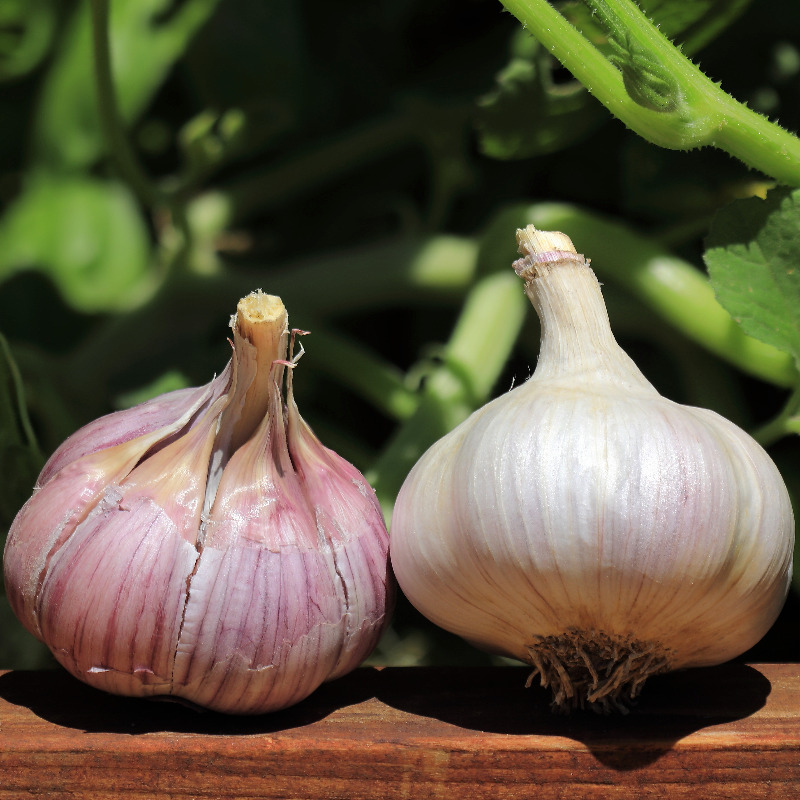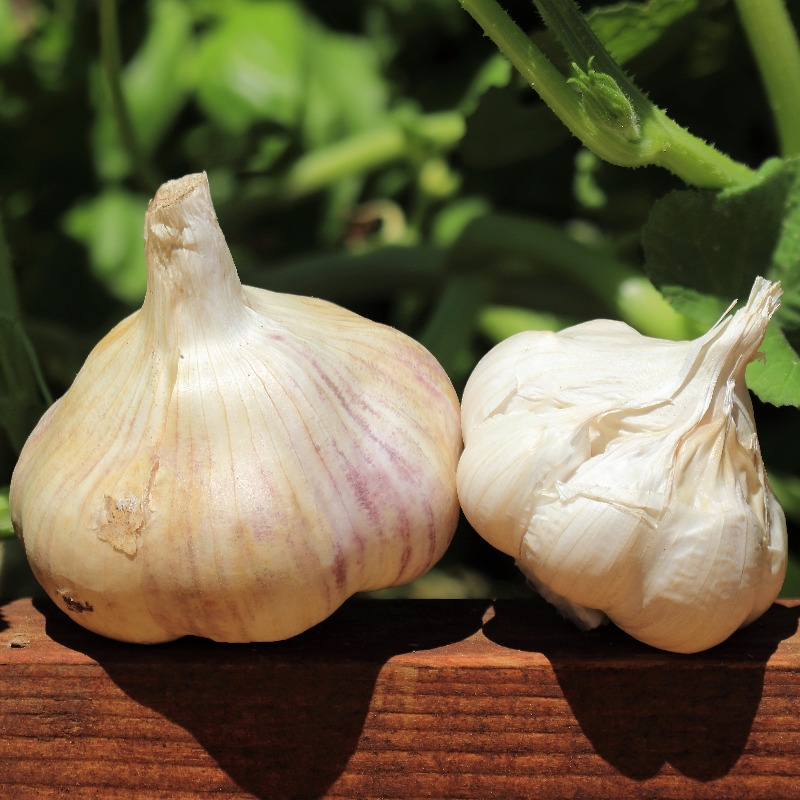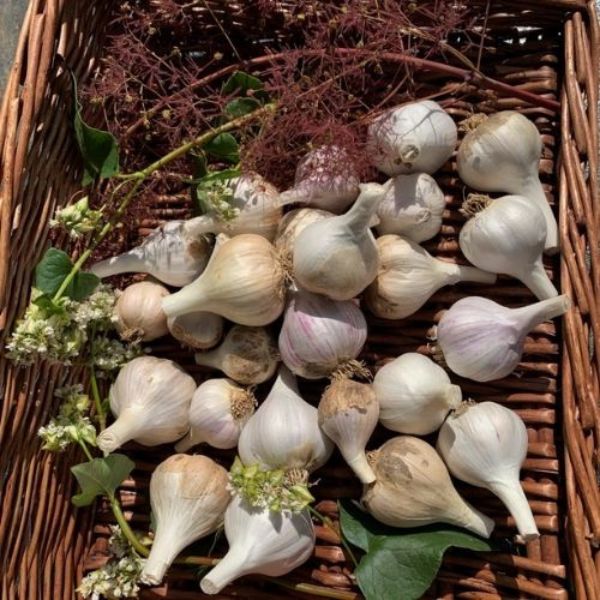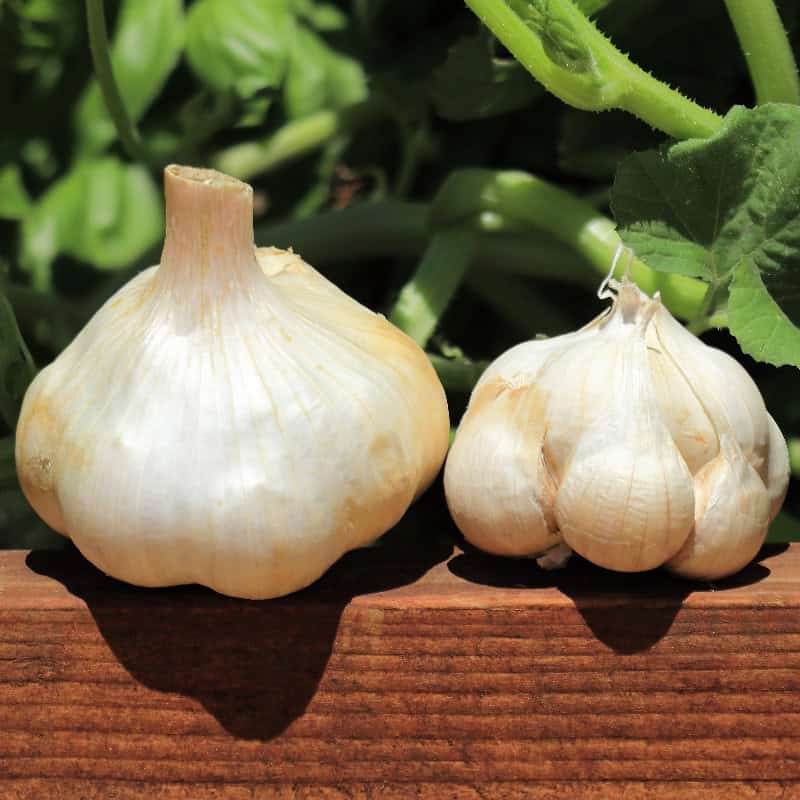About Chesnok Red Garlic Seed
Hardneck – Porcelain
Chesnok Red is an attractive hard-neck varietal from the purple stripe family featuring a stunning cranberry color and large, easy-to-crack heads. This strain, known as ‘Shvelisi,’ is the name of a town in the Southern Republic of Georgia where it originates. It was either brought by immigrants or the USDA convoy that traversed the Caucasus mountains visiting villages and looking for garlic varieties after the fall of the soviet union.
Genetic analysis has revealed that the purple stripe family of hardneck garlic is likely the original cultivar from which all other garlic varieties arose. Purple stripe garlic features tight clove wrappings that help increase its storage time, lasting 7- 9 months in the proper storage conditions.
Chesnok Red Garlic FAQ
Why does Chesnok garlic turn red?
How To Plant Organic Chesnok Red Seed Garlic
Tip: Since Chesnok is a hardneck garlic, the stem at the top of the bulb is hard. Gently tap the hard stem onto a hard surface like a 2×4 piece of wood. This help loosens all the seeds and makes cracking the bulb easy.
When planting cloves in the soil, place the pointy end up 3-4 inches deep and 6 inches apart. Then, cover with your soil and bless the seed. Now is the time to add some mulch or straw to help insulate the garlic from the winter rain or snow. We get some storms that leave 18 inches of snow for a week or two. Garlic loves the vernalization of freezing weather. Even when there is snow on the crop, the seeds slowly send new roots deeper into the ground.
Garlic is an amazing plant; the roots naturally pull the bulbs deeper into the soil. You may want to grow soft neck varieties if you live in a milder climate and do not get hard freezes. Chesnok is a very hardy plant and will grow in any environment. We have had some customers living in the south tell us they have tricked the garlic by placing it in their freezer for two weeks to mimic vernalization, and it produces excellent bulbs.
How To Harvest Chesnok Red Garlic Seeds
When at least 50-75% of your crop has ½ green and brown leaves, stop watering and let the soil dry out. This lack of water stresses the bulbs and quickly increases the bulb size. We stop watering two weeks before we think it’s ready.
When you are confident and happy with the size of the bulb, use a hay fork and carefully loosen the soil 6 to 8 inches away from the bulbs to prevent damage.
Because you have added mulch, the bulbs maybe 6 to 8 inches deep into the soil.
Important: Do not remove the excess dirt with water. Your garlic is drying out, and adding water to wash off dirt is a bad thing, as the garlic will immediately start to absorb the new water. The soil can be removed a few days later when it’s dried with a soft brush. Be careful not to remove the layers of paper on the outside of the garlic.
How To Cure Chesnok Red Garlic
One way to ensure the most prolonged storage Is not to remove the leaves or roots after the garlic is fully cured, 3 to 6 weeks after harvesting. The reasoning is that the leaves and roots left in place until ready for use enhance the flavor by letting the natural moisture slowly evaporate, expanding flavor compounds while your garlic cures.
In both curing methods: Hang bulbs in a well-ventilated, dry area out of direct sunlight at room temperature, ensuring the temperature does not drop below 45 degrees for 3 to 6 weeks. It’s OK if the temperature reaches 90+ degrees for a short period. However, for prolonged high temperatures, use a fan or two to keep the air moving as it aids the drying process.
The Second Method: After 3 to 6 weeks of curing. You can now remove the dirt, leaves, and roots and make them look pretty like you see in supermarkets. You can then put them into ventilated boxes or double paper bags. Place the garlic in the dark, cool, and well-ventilated area. You will get the best results if you can keep the temperature between 45 to 55 degrees. These will store for six months or longer; this method also makes room for items you want to store.
If you want to braid the garlic, ensure the stems have dried slightly but are still flexible. Braiding garlic is an art and much work. We suggest watching how to weave garlic on YouTube as they have many videos.
Garlic hanging time varies depending on the weather in your area; you’ll know it’s done when the roots and leaves are completely dry and easily breakable.
This can take anywhere from 3 – 6 weeks.






Caroline GOULARD (verified owner) –
Once you taste organic grown, you won’t look back. No more store bought so we can choose flavors.
This is our 3rd or 4th order. We will be looking out for their new growth next year. Great service, well packaged. So proud to buy from an organic farmer as we are looking up for our health and support our local organic farmers.
And best of all they are so tasty!
Elijah Mack (verified owner) –
I received my Chesnok Red garlic seeds yesterday afternoon. They were in wonderful shape and very nice sized bulbs and cloves. They smelled wonderful and can’t wait to taste them when cooked with various recipes.
They will be planted shortly and I will share some of the bulbs/cloves with some of my gardening friends who were looking for wonderful bulbs/cloves to plant for this year.
I will be ordering from you again next year.
Have a wonderful week and growing season!
A very satisfied customer!
Elijah Mack
Michael Schallert (verified owner) –
Wonderful tasting garlic I use it for most of my dinner recipes and sometimes for omelettes. So fresh and delicious. I have been a customer since they started and I love to order at the beginning of the season in August. Fast shipping 3-4 days to Wyoming. Thanks keep up the fantastic work.
Caleb Schallert –
I am very impressed with the flavor of this variety. When I got my package the garlic was very fresh and very spicy. I would recommend Basaltic Farms Chesnok Red if you like spicy garlic.